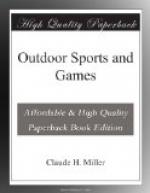A multiplying reel holding sixty yards is large enough for most fishing. The raised pillar reels are the best, one of good quality costing about four dollars. A cheap reel soon goes to pieces.
Silk lines are better than linen because greater strength is obtained with the same thickness. Always dry a line every time it is used, or it will soon rot and be worthless. The back of a chair is excellent for this purpose. Never tie a knot in a line that you expect to use with rod and reel. The knot will always catch in one of the guides just at the time when you are landing your “biggest” fish.
[Illustration: Actual sizes of hooks]
Hooks come in a great variety of shapes and models but there are none better than the standard “Sproat.” It is the general favourite of fishermen everywhere, although of course the other leading models, Carlisle, Limerick, Pennell, Aberdeen, Sneck and a number of others all have their friends.
A great many fishermen make the mistake of using hooks that are too large. The hook sizes that are commonly used are numbered from 6/0, which is the largest, to No. 12, which is a tiny thing about right to catch minnows. Where we expect to catch fish a pound or two in weight, the No. 1 size is about right. Such a hook will catch much larger fish if they happen to come along. I have caught a twelve-pound lake trout on a No. 4 Sproat hook and the hook did not show that it had bent in the least.
Our tackle box should contain an assortment of sizes however. Snelled hooks are better than ringed hooks and those of blued steel better than black enamel. No matter how inexpensive the rest of the equipment is, be sure that your hooks are of good quality. Keep the points sharp. A tiny bit of oil stone, a file, or a piece of emery cloth are all good for this purpose. It takes a sharp point to penetrate the bony jaw of a fish. Always inspect your hook after you have caught it on a rock or snag.
Fishing is generally divided into four classes: fly casting, bait casting, trolling, and still fishing. The average boy is a still fisherman, which means not only that he must keep still, but that his bait remains in one place instead of being trolled or cast about. The usual strings of fish that boys catch, such as perch, sunfish, bullheads, catfish, and whitefish, are called pan fish. This is not entirely a correct name as I have seen some catfish that it would take a pretty big pan to hold. One caught in the Mississippi River weighed over a hundred pounds.




